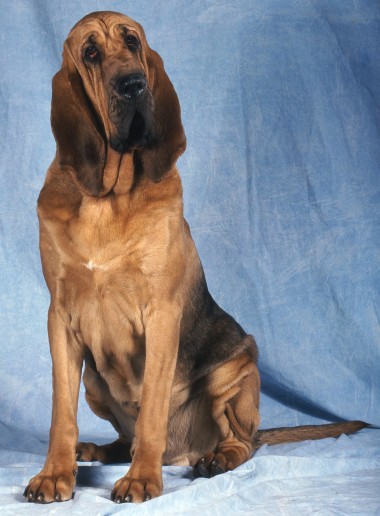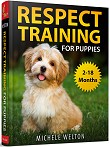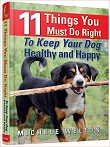Honest FAQ for Bloodhounds
By Michele Welton, Dog Trainer, Behavioral Consultant, Author of 15 Dog Books

Don't get a Bloodhound blindly. Mind his large size, power, and independence. Thoroughly socialize and train while very young and easy to manage.
What kind of temperament and personality does the Bloodhound have?
The most descriptive words that come to my mind regarding Bloodhound temperament and behavior are:
rugged but surprisingly easygoing and sensitive; a bit clumsy and goofy; champion slobberer; stubborn, independent, single-minded tracker, big SNIFFY hound says "BAHrrrooo"!
I give you my honest opinions about Bloodhound temperament and personality traits and characteristics – positives AND negatives – in my dog breed review, Bloodhound Temperament and Personality Traits (What's Good About 'Em, What's Bad About 'Em).
Where did the name Bloodhound come from?
This very old scenthound originated in medieval Europe, where he was kept "of pure blood" and owned only by aristocratic bluebloods, hence the name "blooded hound."
What were Bloodhounds used for?
Hunting. Medieval bishops on horseback followed packs of Bloodhounds, seeking game animals such as foxes.
Finding people. Bloodhounds are the most relentless man-trailers in the world. For two centuries, they've been used by law enforcement to track and find poachers, thieves, escaped prisoners, and lost childen. With single-minded focus, a Bloodhound will trail people, day and night, through the most rugged terrain, without giving up.
Bloodhounds are also used by Search & Rescue organizations.
How big are Bloodhounds? Height and weight?
About 24-29 inches at the shoulder, and 90-130 pounds, which puts them in the LARGE or GIANT category.
What colors do Bloodhounds come in?
Black and tan, liver and tan, or solid red (tawny/tan).
Do Bloodhounds come in different "types"?
Yes and no. Bloodhounds bred exclusively for exhibition in the dog show ring are often more laid-back, while those bred exclusively for hunting or trailing often have a more energetic, more driven temperament. But some breeders participate in both activities, aiming to produce a more balanced Bloodhound.
Do Bloodhounds have a doggy odor?
Yes, Bloodhounds, like most other scenthound breeds, tend to have a musty doggy odor. They're also "gassy" dogs.
How much exercise do Bloodhounds need?
Much more than you might think. Bloodhounds can sometimes appear "lazy", content to lie around and snore. The problem is, when they wake up, if you haven't been providing enough ongoing daily exercise, you may discover how much trouble a bored Bloodhound can get into!
This breed can be a massive chewer, and even worse, often swallows whatever he's ripping off your walls or carpet. Then you'll need to rush for the veterinary emergency room.
Much better to keep your Bloodhound exercised! Now, he doesn't need hours of running – not at all. He's satisfied with an hour of brisk walking, every day, plus a large yard that he can roam around in (and dig massive craters in!). Never let a Bloodhound off leash outside a securely fenced area.
In addition, you simply MUST get your Bloodhound involved in what he does best. Bloodhounds are so valuable in a community emergency that all owners should involve their hounds in the American Bloodhound Club Man-Trailing program. Your Bloodhound could save the life of a lost child or disoriented senior citizen.
Do Bloodhounds need a fenced yard?
Yes, preferably with a high fence, as Bloodhounds can be wanderers and escape artists.Why a fenced yard? and best and worst fences.
Are Bloodhounds easy to train?
Train for what? Tracking and trailing? They take to that like a duck takes to water.
But obedience training? Not so much! Bloodhounds are both independent and stubborn. They see very little point in walking politely on the leash or coming when called or sitting on command. Thus, Bloodhounds tend to gnore your wishes unless you're an assertive person who can "read" and respond to a strong-willed working dog and establish a healthy leader-follower relationship.
Otherwise a Bloodhound is likely to walk all over you. In a good-natured, goofy way, sure... but you're still be walked over! This breed is not for beginners.
Are Bloodhounds easy to housebreak?
They're about average... sometimes a bit slower, but they'll get there.
Are Bloodhounds friendly with people?
Some Bloodhounds are friendly with everyone. Others are more standoffish, but still polite. A Bloodhound should never be aggressive.
Unfortunately there is skittishness and shyness in some lines and some individuals. These temperament flaws can be just as risky as aggression because a fearful dog can bite defensively, and you never want such a powerful dog to bite anyone. So be careful where you get your Bloodhound, evaluate both parents thoroughly, and socialize your Bloodhound puppy.
Are Bloodhounds good with children?
Bloodhounds are usually good-natured with children, but because of their size, strength, and clumsiness, they're better with older, sturdier kids.
Are Bloodhounds good with other dogs?
Bloodhounds are usually fine with other dogs in their own family. However, some can be dominant and pushy toward other dogs of the same sex.
Are Bloodhounds good with cats?
It's iffy. Some Bloodhounds are tolerant with cats in their own family. But with his hunting heritage, you should expect that small running pets might be chased. So...
How much do Bloodhounds shed?
Bloodhounds are average shedders. Their sleek coat sheds moderately in the spring and fall, and occasionally a tiny bit of hair the rest of the year.
Are Bloodhounds hypoallergenic? Good for people with allergies?
If you're allergic to dog dander, no. If you're allergic to canine saliva, no. Bloodhounds are not hypoallergenic dogs.
How much grooming do Bloodhounds need?
Just an occasional quick brush to sweep the dirt, dander, and loose hair off your dog's skin.
What's a good training schedule for training Bloodhound puppies?
Here's the puppy training schedule I use for Bloodhounds: Puppy Training Schedule.
What behavior problems do Bloodhounds tend to have?
Fortunately, most people who get a Bloodhound know what they're doing! They've either had other Bloodhounds before, or they're being mentored by other Bloodhound owners. So they know how to provide their big klutzy pal with proper exercise and challenging activities.
But I have gotten calls from owners who didn't know what they were getting into and now their big klutzy pal has selective hearing and is off doing his own thing while the owner stands in the yard shouting, "Beauregard! Come! Beauregard, you blankety-blank!"
Common behavior issues in Bloodhounds include:
- Baying in their deep, soulful voice – "BAHrrrrrrooo! BAHrrrrooo!"
- Digging craters
- Chewing and swallowing whatever fits in their mouth
- Drooling, slobbering, tracking in mud... this is a rugged country dog, not for fastidious households.
The critical puppy and adolescent periods are when you must teach calmness, establish the right leader/follower relationship, and respond properly to behavior problems.
What health problems might Bloodhounds have?
An emergency (often fatal) digestive syndrome called bloat (gastric torsion) is the greatest health-related fear of Bloodhound owners. Also cancer and heart disease. And loose hip or elbow joints that lead to lameness and crippling arthritic pain.
What breeds are similar to the Bloodhound?
You might consider one of the Coonhound breeds, especially the Black and Tan Coonhound.
Where can I buy a Bloodhound puppy?
Show breeder, performance/working breeder? Read my article.
Where can I adopt an older Bloodhound?
Rescue group or humane society/shelter? Read my article.
I just got a new Bloodhound. Which pages should I read first?
- Bloodhound Health, which includes my advice on feeding, vaccinations, and daily health care. These pages are very important, because if you start your Bloodhound puppy off on the wrong foot, he will probably experience health problems later on. Starting off right is essential.
- Training Bloodhounds, which includes my advice on respect training, housebreaking, and socialization. Again, you must start your Bloodhound puppy off on the right foot by teaching him what he needs to know, and you must avoid doing the wrong things with him so that he doesn't develop bad habits that will be much harder to fix later on.
Do male dogs or female dogs make better pets?
Ah, let the debate begin! Honestly, male Bloodhounds have pros and cons, and female Bloodhounds have pros and cons. Visit Male Dogs versus Female Dogs
There's an adorable Bloodhound puppy at the pet shop. The store manager assures me they only buy from responsible breeders. Could this be true?
No responsible Bloodhound breeder would ever place one of their Bloodhound puppies in a pet shop for resale. To find out more about pet shop puppies, visit Pet Shop Puppies: Buying a Puppy From a Pet Store.
How do I pick the best Bloodhound puppy from a litter?
You can do puppy personality tests. Visit How To Choose a Good Puppy.
What's the best dog food for Bloodhounds?
3 Best Ways To Feed Your Dog Healthy Food.
I have to take my Bloodhound to the vet soon for shots. Which vaccinations does he really need?
The schedule of vaccinations that dogs really need has changed dramatically – but unfortunately most vets are not telling you this, because a good chunk of their income depends on frequent vaccinations. Please don't get any more shots for your Bloodhound until you've read my article on Puppy Shots and Dog Vaccinations.
What are the pros and cons of spaying and neutering my Bloodhound, and when should it be done?
Spaying and neutering are often recommended too early, which can lead to health problems later in life. Visit Spaying Your Female Dog or Neutering Your Male Dog for the straight scoop on the safest (and riskiest) times to spay or neuter.
I have a question about Bloodhounds that I don't see answered on your web site.
It's probably answered in one of my free online books.
My best-selling books – now available FREE on my website
 Respect Training For Puppies: 30 seconds to a calm, polite, well-behaved puppy is for puppies 2 to 18 months old. Your puppy will learn the 21 skills that all family dogs need to know. Click here to read for free.
Respect Training For Puppies: 30 seconds to a calm, polite, well-behaved puppy is for puppies 2 to 18 months old. Your puppy will learn the 21 skills that all family dogs need to know. Click here to read for free. Teach Your Dog 100 English Words is a unique Vocabulary and Respect Training Program that will teach your adult dog to listen to you and do what you say. Click here to read for free.
Teach Your Dog 100 English Words is a unique Vocabulary and Respect Training Program that will teach your adult dog to listen to you and do what you say. Click here to read for free. 11 Things You Must Do Right To Keep Your Dog Healthy and Happy helps your dog live a longer, healthier life. Get my honest advice about all 11 Things before you bring home your new puppy, because some mistakes with early health care cannot be undone. Click here to read for free.
11 Things You Must Do Right To Keep Your Dog Healthy and Happy helps your dog live a longer, healthier life. Get my honest advice about all 11 Things before you bring home your new puppy, because some mistakes with early health care cannot be undone. Click here to read for free.

